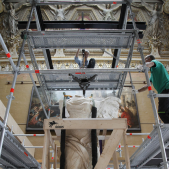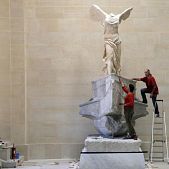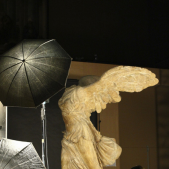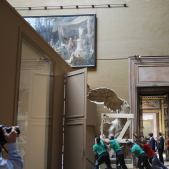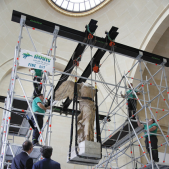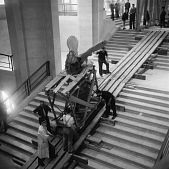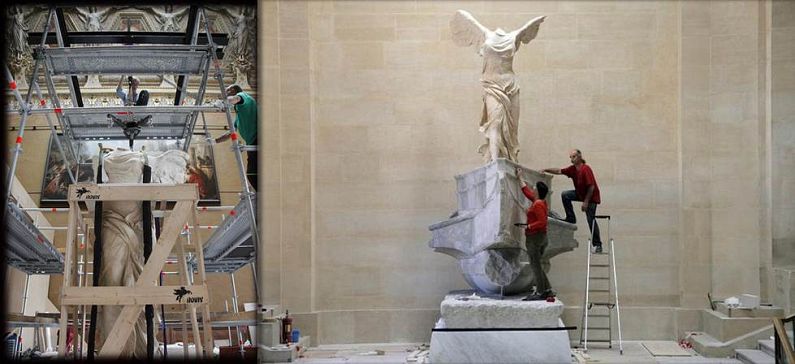
The restored Winged Victory of Samothrace returns to Louvre
The Winged Victory of Samothrace returns to the Louvre Museum after almost a year away from its majestic pedestal due to its restoration.
Since September, a team of eight archaeologists has worked meticulously on cleaning the representation of Nike, the Greek goddess of victory, to give it back the natural white shade of its marble after more than a century of dust and filth rendered it a dirty yellow. They also cleaned the base, designed as a prow of a ship, to restore the veined-grey color and the contrast with the Goddess that was also lost with time.
This week the 29-ton statue was reinstalled on its splendid location, close to the Grande Gallerie, where visitors will be able to admire it.
The Winged Victory is one of the five most popular works at the Louvre Museum, which attracts almost 10 million visitors a year. Given its importance and its weight, it was the first time since World War II the statue was moved and the first time it was restored since it was installed in the staircase.
Restoring old, stained marble is complicated and delicate work. The conservationists cleaned the white marble with compresses soaked in water to protect the old stone and erase the layers of grime.
The work on the Winged Victory was made more complex by reconstitutions in the 19th century. When the statue was brought to Paris from the Greek island of Samothrace, near Turkey’s Dardanelles Straits, the statue was broken in several pieces. Museum experts in the late 19th century covered the joints with plaster and painted over it. The restoration team replaced the plaster with a marble-base binder so that no paint would be needed.
The statue’s right wing was missing, as was a fragment to connect the left wing with the torso. Museum experts at the time did something archaeologists wouldn’t do now: they added a new right wing in plaster, symmetrical to the original left one. They also created a missing left breast, to connect the original wing to the torso.
Those reconstitutions were historically inaccurate, experts now agree. But the restoration team decided to leave the modifications untouched as the statue is not only a testimony of Hellenistic fine art, but is also an example of 19th century art taste, said Ludovic Laugier, the head of the Antiquity department at the Louvre Museum, who oversaw the restoration.
The Winged Victory originally stood in Samothrace on a cliff towering over the esplanade of the Sanctuary of the Great Gods, a complex of a dozen temples dedicated to different deities popular in Antiquity. The religious center gradually lost worshipers with the rise of Christianity. The statue was probably made in the second century B.C. and fell from its pedestal in an earthquake centuries later, Mr. Laugier said.
A work of restoration like this one is also an occasion for scientists to do some research on the art piece. Giovani Verri, from the Courtauld Institute of Art identified microscopic traces of blue paint, showing the statue was partly colored with at least a blue fringe on the drapery. He also found blue pigments on the wing.
The restorers were also able to add some fragments of the drapery and the left wing’s superior flight feather to the statue. All were brought by the Champoiseau expedition. Even though the fragments on the drapery are difficult to notice, the added feather does make a difference.
Since the 19th century, archaeologists have been searching and investigating in Samothrace continuously and some fragments from the Winged Victory and from the ship prow have been found more recently.
The statue is not just a fine piece of Greek art, said Rena de Sisto, the head of marketing for Bank of America Merrill Lynch, which sponsored the project along with French financial firm FImalac, Japan’s Nippon TV Holdings and more than 6,000 individual donors. “She is a symbol of Western civilization. A woman being an embodiment of freedom is to a certain extent a precursor of our Statue of Liberty”.
No matter where the statue is located, Ms. DeSisto said, the restoration has made it better and that is what matters.



